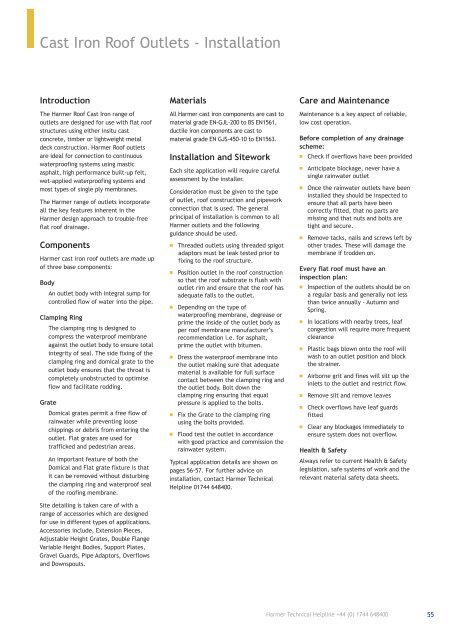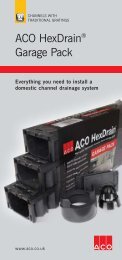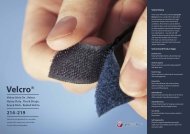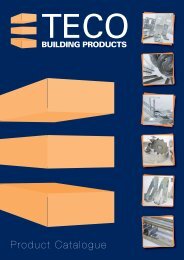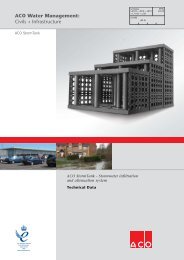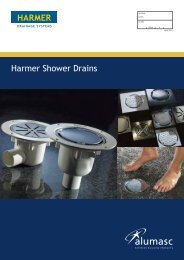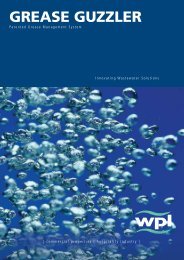Create successful ePaper yourself
Turn your PDF publications into a flip-book with our unique Google optimized e-Paper software.
Cast Iron <strong>Roof</strong> Outlets - Installation<br />
Introduction<br />
The <strong>Harmer</strong> <strong>Roof</strong> Cast Iron range of<br />
outlets are designed for use with flat roof<br />
structures using either insitu cast<br />
concrete, timber or lightweight metal<br />
deck construction. <strong>Harmer</strong> <strong>Roof</strong> outlets<br />
are ideal for connection to continuous<br />
waterproofing systems using mastic<br />
asphalt, high performance built-up felt,<br />
wet-applied waterproofing systems and<br />
most types of single ply membranes.<br />
The <strong>Harmer</strong> range of outlets incorporate<br />
all the key features inherent in the<br />
<strong>Harmer</strong> design approach to trouble-free<br />
flat roof drainage.<br />
Components<br />
<strong>Harmer</strong> cast iron roof outlets are made up<br />
of three base components:<br />
Body<br />
An outlet body with integral sump for<br />
controlled flow of water into the pipe.<br />
Clamping Ring<br />
The clamping ring is designed to<br />
compress the waterproof membrane<br />
against the outlet body to ensure total<br />
integrity of seal. The side fixing of the<br />
clamping ring and domical grate to the<br />
outlet body ensures that the throat is<br />
completely unobstructed to optimise<br />
flow and facilitate rodding.<br />
Grate<br />
Domical grates permit a free flow of<br />
rainwater while preventing loose<br />
chippings or debris from entering the<br />
outlet. Flat grates are used for<br />
trafficked and pedestrian areas.<br />
An important feature of both the<br />
Domical and Flat grate fixture is that<br />
it can be removed without disturbing<br />
the clamping ring and waterproof seal<br />
of the roofing membrane.<br />
Site detailing is taken care of with a<br />
range of accessories which are designed<br />
for use in different types of applications.<br />
Accessories include, Extension Pieces,<br />
Adjustable Height Grates, Double Flange<br />
Variable Height Bodies, Support Plates,<br />
Gravel Guards, Pipe Adaptors, Overflows<br />
and Downspouts.<br />
Materials<br />
All <strong>Harmer</strong> cast iron components are cast to<br />
material grade EN-GJL-200 to BS EN1561,<br />
ductile iron components are cast to<br />
material grade EN GJS-450-10 to EN1563.<br />
Installation and Sitework<br />
Each site application will require careful<br />
assessment by the installer.<br />
Consideration must be given to the type<br />
of outlet, roof construction and pipework<br />
connection that is used. The general<br />
principal of installation is common to all<br />
<strong>Harmer</strong> outlets and the following<br />
guidance should be used.<br />
■<br />
■<br />
■<br />
■<br />
■<br />
■<br />
Threaded outlets using threaded spigot<br />
adaptors must be leak tested prior to<br />
fixing to the roof structure.<br />
Position outlet in the roof construction<br />
so that the roof substrate is flush with<br />
outlet rim and ensure that the roof has<br />
adequate falls to the outlet.<br />
Depending on the type of<br />
waterproofing membrane, degrease or<br />
prime the inside of the outlet body as<br />
per roof membrane manufacturer’s<br />
recommendation i.e. for asphalt,<br />
prime the outlet with bitumen.<br />
Dress the waterproof membrane into<br />
the outlet making sure that adequate<br />
material is available for full surface<br />
contact between the clamping ring and<br />
the outlet body. Bolt down the<br />
clamping ring ensuring that equal<br />
pressure is applied to the bolts.<br />
Fix the Grate to the clamping ring<br />
using the bolts provided.<br />
Flood test the outlet in accordance<br />
with good practice and commission the<br />
rainwater system.<br />
Typical application details are shown on<br />
pages 56-57. For further advice on<br />
installation, contact <strong>Harmer</strong> Technical<br />
Helpline 01744 648400.<br />
Care and Maintenance<br />
Maintenance is a key aspect of reliable,<br />
low cost operation.<br />
Before completion of any drainage<br />
scheme:<br />
■ Check if overflows have been provided<br />
■<br />
■<br />
■<br />
Anticipate blockage, never have a<br />
single rainwater outlet<br />
Once the rainwater outlets have been<br />
installed they should be inspected to<br />
ensure that all parts have been<br />
correctly fitted, that no parts are<br />
missing and that nuts and bolts are<br />
tight and secure.<br />
Remove tacks, nails and screws left by<br />
other trades. These will damage the<br />
membrane if trodden on.<br />
Every flat roof must have an<br />
inspection plan:<br />
■ Inspection of the outlets should be on<br />
a regular basis and generally not less<br />
than twice annually - Autumn and<br />
Spring.<br />
■<br />
■<br />
■<br />
■<br />
■<br />
■<br />
In locations with nearby trees, leaf<br />
congestion will require more frequent<br />
clearance<br />
Plastic bags blown onto the roof will<br />
wash to an outlet position and block<br />
the strainer.<br />
Airborne grit and fines will silt up the<br />
inlets to the outlet and restrict flow.<br />
Remove silt and remove leaves<br />
Check overflows have leaf guards<br />
fitted<br />
Clear any blockages immediately to<br />
ensure system does not overflow.<br />
Health & Safety<br />
Always refer to current Health & Safety<br />
legislation, safe systems of work and the<br />
relevant material safety data sheets.<br />
<strong>Harmer</strong> Technical Helpline +44 (0) 1744 648400<br />
55


